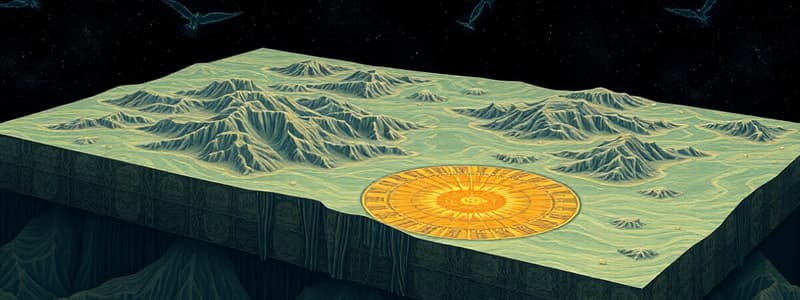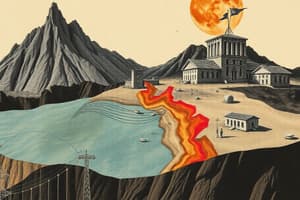Podcast
Questions and Answers
Qual das seguintes aplicações da sismologia está relacionada à exploração de recursos naturais?
Qual das seguintes aplicações da sismologia está relacionada à exploração de recursos naturais?
- Monitoramento sísmico para detecção de terremotos.
- Compreensão da estrutura interna e composição da Terra.
- Projeto de estruturas resistentes a terremotos.
- Localização de depósitos de petróleo, gás e recursos hídricos subterrâneos. (correct)
O que representa a profundidade focal de um terremoto?
O que representa a profundidade focal de um terremoto?
- A intensidade das ondas sísmicas na superfície.
- A distância entre o epicentro e a falha geológica.
- A magnitude do terremoto na escala Richter.
- O ponto de ruptura inicial abaixo da superfície da Terra. (correct)
Como as falhas geológicas influenciam a ocorrência de terremotos?
Como as falhas geológicas influenciam a ocorrência de terremotos?
- Elas estabilizam as placas tectônicas, diminuindo a frequência de terremotos.
- Elas aumentam a pressão interna da Terra, gerando terremotos de maior magnitude.
- Elas atuam como barreiras, impedindo a propagação das ondas sísmicas.
- Elas são fraturas na crosta terrestre onde ocorre movimento, liberando energia e causando terremotos. (correct)
Qual a relação entre a tectônica de placas e a ocorrência de terremotos?
Qual a relação entre a tectônica de placas e a ocorrência de terremotos?
Qual é a importância de entender o contexto geológico de um terremoto?
Qual é a importância de entender o contexto geológico de um terremoto?
Qual dos seguintes fenômenos é a principal causa de terremotos?
Qual dos seguintes fenômenos é a principal causa de terremotos?
Qual tipo de onda sísmica é uma onda de cisalhamento que viaja através do interior da Terra e não consegue se propagar em meios líquidos?
Qual tipo de onda sísmica é uma onda de cisalhamento que viaja através do interior da Terra e não consegue se propagar em meios líquidos?
Qual escala é atualmente considerada a mais precisa para medir a magnitude de um terremoto, especialmente para eventos de grande porte?
Qual escala é atualmente considerada a mais precisa para medir a magnitude de um terremoto, especialmente para eventos de grande porte?
Qual dos seguintes efeitos de um terremoto ocorre quando sedimentos saturados perdem sua resistência e se comportam como um líquido?
Qual dos seguintes efeitos de um terremoto ocorre quando sedimentos saturados perdem sua resistência e se comportam como um líquido?
Qual tipo de onda sísmica causa movimento vertical e horizontal do solo em um padrão elíptico retrógrado?
Qual tipo de onda sísmica causa movimento vertical e horizontal do solo em um padrão elíptico retrógrado?
Qual dos seguintes fatores NÃO é normalmente considerado na avaliação do risco sísmico de uma região?
Qual dos seguintes fatores NÃO é normalmente considerado na avaliação do risco sísmico de uma região?
Qual das seguintes opções descreve corretamente a diferença fundamental entre magnitude e intensidade em relação a terremotos?
Qual das seguintes opções descreve corretamente a diferença fundamental entre magnitude e intensidade em relação a terremotos?
Além do movimento de placas tectônicas, qual dos seguintes fenômenos naturais pode desencadear terremotos?
Além do movimento de placas tectônicas, qual dos seguintes fenômenos naturais pode desencadear terremotos?
Flashcards
Monitoramento sísmico
Monitoramento sísmico
Ajuda a detectar terremotos e prever suas ocorrências.
Tipos de falhas
Tipos de falhas
Fraturas na crosta terrestre que revelam diferentes movimentos.
Profundidade foco
Profundidade foco
Ponto de ruptura inicial sob a superfície da Terra.
Tectônica de placas
Tectônica de placas
Signup and view all the flashcards
Estruturas geológicas
Estruturas geológicas
Signup and view all the flashcards
Sismologia
Sismologia
Signup and view all the flashcards
Causas dos terremotos
Causas dos terremotos
Signup and view all the flashcards
Ondas sísmicas
Ondas sísmicas
Signup and view all the flashcards
Ondas P
Ondas P
Signup and view all the flashcards
Escala de Richter
Escala de Richter
Signup and view all the flashcards
Liquefação
Liquefação
Signup and view all the flashcards
Avaliação de risco sísmico
Avaliação de risco sísmico
Signup and view all the flashcards
Tsunamis
Tsunamis
Signup and view all the flashcards
Study Notes
Introduction to Seismology
- Seismology is the scientific study of earthquakes and seismic waves.
- It involves understanding the causes, mechanisms, and effects of earthquakes.
- Seismology is essential for assessing seismic hazards and mitigating their impacts.
- This study also examines the Earth's internal structure through seismic wave analysis.
Earthquake Causes
- Earthquakes are primarily caused by the movement of tectonic plates.
- These plates interact at boundaries, generating stress and strain.
- Sudden release of this stress leads to the rupture of rocks, producing seismic waves.
- Other factors can trigger earthquakes, including volcanic activity, landslides, and human activities (e.g., large reservoir impoundment).
Types of Seismic Waves
- Body waves propagate through the Earth's interior.
- P-waves (primary waves) are compressional waves, traveling fastest.
- S-waves (secondary waves) are shear waves, slower and requiring a solid medium to travel through.
- Surface waves travel along the Earth's surface.
- Love waves are horizontal shear waves.
- Rayleigh waves are retrograde elliptical waves, causing vertical and horizontal ground motion.
Earthquake Measurement
- Magnitude measures the size of an earthquake.
- Richter scale (older)
- Moment magnitude scale (more modern and precise).
- Intensity describes the effects of an earthquake at a particular location.
- Modified Mercalli Intensity Scale assesses damage and human perception.
- Seismographs record ground motion, providing data for earthquake analysis.
Seismic Hazard Assessment
- Earthquake hazard assessment involves determining the probability of future earthquakes.
- This includes identifying earthquake-prone areas based on geological data, fault activity, and historical records.
- Seismic zonation maps categorize areas based on seismic risk.
- Seismic hazard analysis considers the potential for ground shaking, landslides, liquefaction, and tsunamis.
Earthquake Effects
- Ground shaking is the primary effect of an earthquake, causing damage to structures.
- Liquefaction occurs in saturated sediments, leading to ground failure.
- Landslides and ground failure can occur due to slope instability triggered by seismic activity.
- Tsunamis are devastating ocean waves generated by underwater earthquakes or submarine landslides.
- Other effects include damage to infrastructure, casualties, and economic loss.
Applications of Seismology
- Seismic monitoring helps detect earthquakes and predict their potential occurrences.
- Seismology aids in understanding the Earth's interior structure and composition.
- It informs the design of earthquake-resistant structures.
- Seismic data aids in locating oil and gas deposits, as well as underground water resources.
Geological Aspects of Earthquakes
- Faults are fractures in the Earth's crust along which movement has occurred.
- Different types of faults, including strike-slip, dip-slip, and oblique-slip faults drive different characteristics in earthquake occurrences.
- The focal depth of an earthquake refers to the point of initial rupture beneath the earth's surface, varying based on the type of fault and tectonic context.
- Geological structures such as pre-existing faults, fractures, and weaknesses in the rock play a crucial role in determining the location and magnitude of earthquakes.
- Understanding the geological context of an earthquake is critical to predicting its behavior.
Seismology and Plate Tectonics
- Plate tectonics is the theory that describes the large-scale motion of Earth's lithosphere.
- Earthquakes occur primarily along plate boundaries where plates collide, separate, or slide past each other.
- The characteristics of earthquakes, such as magnitude, depth, and frequency, are largely linked to the type of plate boundary involved.
- Studying earthquakes aids in our understanding of how the Earth's plates are moving and interacting.
Studying That Suits You
Use AI to generate personalized quizzes and flashcards to suit your learning preferences.



